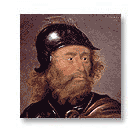| |
| |
| Anglo-Norman power in Ireland began to fade in Ireland, more and more of the country fell back into the hands of the Gaels, Donnell O'Neill king of Tir-Owen and some of the other Lords impatient to see the end of Norman rule, invited Edward Bruce to Ireland in 1315, this perhaps was a little ironic as the Bruce's were themselves of Norman decent. Their ancestor Robert de Brusse of Cherbourg came to England with William the Conqueror in 1066 his son Robert (1078- 1141) was a companion in arms of King David I of Scotland from whom he received a grant of the lordship of Annandale in Dumfriese and Galloway. In
1315 the English although outnumbering the Scots by three to one were
defeated by Battle of Bannochburn at Answers.com After Bannochburn Edward, Earl of Galloway, had thousands of soldiers at his disposal, bolstered by his recent successes, and encouraged by Robert, who perhaps fearful of Edwards fierce ambition seen a campaign in Ireland led by Edward as a means of extending the families power, and averting a power struggle between the two in the future. On May 25th 1315 Edward landed a force of some six thousand men at Larne in county Antrim. These men were mail clad battle hardened veterans, they were soon joined by large numbers of Irish infantry. This Scottish-Irish alliance proved to be almost invincible, proceeding from victory to victory. They defeated Hugh de Lacys and Hugh de Montford at Kells and won many other battles further south. One prize that eluded them was Carrickfergus Castle which was still in the hands of the English. At the outset Edward left a portion of his army to lay siege to the castle. During Easter 1316 Sir Thomas de Mandeville attempting to relieve the castle by an approach from the sea was defeated and killed. After about a year on 1st May 1316 Edward crowned himself king of Ireland at Dundalk. By September that year when he was joined by his brother Robert, most of northern portion of Ireland was under his control, September of that year saw the surrender of Carrickfergus. The two brothers took most of the midlands, but Dublin eluded them, mainly because as was the case in Carrickfergus, they lacked siege engines. Their conquest and pillage of the country to sustain their army's, led inevitably to famine. In 1317 Robert went north to Ulster and from thence to Scotland to attend to his business, promising to send men and supplies. By 1318 most of the island was in the grip of famine, one notable battle took place near Ennis county Clare, in the battle of Disert O'Dea the O'Brien's regained their kingship. The tide of good fortune was about to turn against Edward, in the late summer of 1318 a superior force led by John de Birmingham was marching against him. The two armies met on 14th October 1318 at Faughart near Dundalk county Louth, Edward was killed and his army defeated, the remnants of Edward's army returned home as best they could. His Irish allies suffered greatly after the defeat. A chronicler wrote of Bruce at the time |
||
|
|

 Robert Bruce king
of Scotland and his brother Edward at the battle of Bannochburn. Thereby
gaining their long fought for independence from England. Upon learning
of the Bruce victory, O'Neill of Tyrone (Brother in law of Robert)
invited the Bruce's to Ireland, offering to make Edward King of Ireland.
Robert Bruce king
of Scotland and his brother Edward at the battle of Bannochburn. Thereby
gaining their long fought for independence from England. Upon learning
of the Bruce victory, O'Neill of Tyrone (Brother in law of Robert)
invited the Bruce's to Ireland, offering to make Edward King of Ireland.